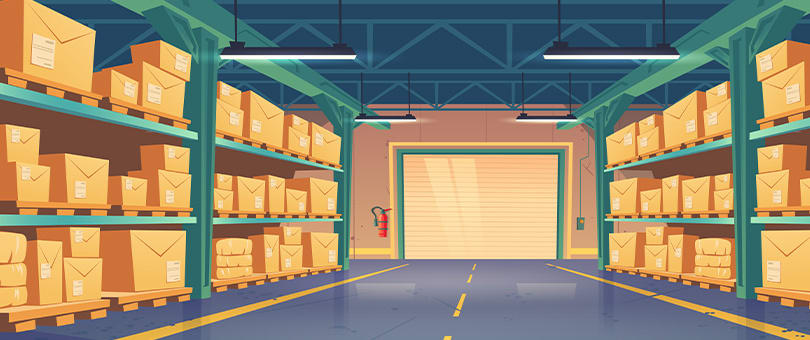Technology advancements have become a crucial competitive advantage in almost every sector in the modern world. And warehousing is not an exception. To continue thriving, warehousing organizations have to adapt to technological developments. Let’s look into warehouse automation trends that matter in 2021.
The Rise of Warehouse Robotics Innovations
Warehouse robotics is one of the leading technology trends in warehousing. It’s a common term for a group of automated systems, robotics, and specialized software used to enhance speed, efficiency, and accuracy. They may either replace human workers or collaborate with them, performing various tasks in warehouses. Based on the performed tasks, there are several common warehouse jobs performed by robots:
- Pallet movers
- Pallet builders
- Pickers
- Floor cleaners
- Barcode scanners
 How are robots beneficial for warehousing in addition to automating its operations?
How are robots beneficial for warehousing in addition to automating its operations? - Robotics automated systems reduce injury risk, improving the overall safety within warehouses.
- They boost order efficiency and productivity of warehouse workers. According to Conveyco, the implementation of an automated order processing system can increase overall productivity by 25%.
- Human errors are reduced, making picking and order processing more accurate. According to MHI estimation, warehouse robots can increase accuracy to over 99. 99%.
- With warehouse robots, organizations can save on workforce costs, while closing the labor shortage gap at the same.
- Finally, human workers can focus their initiatives on more value-added tasks, rather than repetitive tasks that warehouse robots can perform.
A lot of large companies operating in the warehousing industry have already integrated robotics innovations into their operational workflow. Among the most popular are:
*AGVs (automated guided vehicles)
*AMRs (autonomous mobile robots)
*Collaborative robots, or cobots
Mobile Robots: AGV/AMR
Some of the industry experts have predicted that about 50000 warehouses will adopt autonomous warehouse software by 2025.
AGVs (automated guided vehicles) and AMRs (autonomous mobile robots) are easy to train for performing various warehousing tasks such as sorting, packaging, transporting, or batching. AGVs are typically used for transportation or performing tasks usually conducted by manual forklifts, conveyors, towing machines, and carts. Compared to AGVs, AMRs are more flexible and can perform more complicated tasks like moving or picking goods.
They are based on AI technology that enables them to move around the warehouse with minimal or no human interaction. According to 2020’s Global Warehouse Automation Market Report, it is expected that AGVs/AMRs are going to have more than 18% market share by 2026 in the overall warehouse automation market.
Cobots
Cobots are created to work in collaboration with human workers to complete tasks. They typically support human workers in taking on repetitive, laborious, and sometimes dangerous tasks. Collaborative robots don’t replace human workers while assisting them with the most repetitive task. Being trained by ML models, they help pick inventory items as they can travel around and remain in the work area. Before the COVID-19 pandemic, it was estimated that cobots will comprise 34% of total robot sales by 2025.
Gamification in Warehouse Management
Gamification is another trend in warehouse management that improves the overall productivity of the warehousing staff. This innovative management technology may be used in different ways to encourage employees to perform better based on an automated reward system. For instance, you can install dynamic scoreboards to make every item moved meaningful and gamify the working experience. By getting more motivated, employees are more inspired to perform to the best of their abilities. In general, a well-designed gamification application provides much valuable information about the organization’s efficiency.
IoT and Analytics Trends in Warehousing
The scope of IoT services in a warehouse is substantial. It provides visibility into automated warehousing operations. Combined with AI, they create a new powerful tool – AIoT – that enables wireless fleet management within warehouses smarter than ever before. Like the cargo and transportation industry, warehousing organizations use sensors to track operational activities of forklifts and other transportation units to gain valuable insights.
Together with other warehouse automation examples, telematics solutions are the key to well-informed decisions in warehouse management. Thus, by tracking the activities of vehicles, warehouse managers can instantly respond to potential issues or unexpected reorganization of workload.
When it comes to big data services, warehouse owners have already adopted that trend in their operations. Having understood how much valuable data are kept on their facilities, they now make use of sensors and data they collect. According to a survey, up to 80% of respondents point to Big Data as a core competency.
Using Big Data for Improving Performance in Warehouses
Demand Prediction
One of the key benefits Big Data can bring to warehouses is how this technology helps to analyze huge amounts of data. They give a better insight into consumer product demands, enabling manufacturers and retailers to make predictions and well-informed decisions on what amounts of goods to produce or purchase.
Real-Time Visibility
Another thing that you can leverage from BI solutions is enhanced transparency in real-time. You can monitor vehicle or automation system activities and location to be ready for unexpected issues.
Wearables for Inventory Management Automation
Surprisingly, many organizations still utilize manual spreadsheets for inventory tracking and management. The Big Data technology advancements allow enterprises to use more effective ways to handle inventory items like wearables that read barcodes of RFID tags. Digital barcodes and tags typically contain a lot of information about an item, ranging from when it was delivered to its manufacturer.
In a Nutshell
The latest technology trends provide new opportunities for warehouse management system development, enabling the enterprise with competitive advantages in the markets. Not all of them may be cost-effective for small or mid-size organizations, but there’s no doubt that warehouse management technologies have significantly changed over the past years.








Top comments (0)